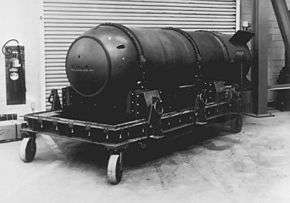Mark 15 nuclear bomb
The Mark 15 nuclear bomb, or Mk-15, was a 1950s American thermonuclear bomb, the first relatively lightweight (7,600 lb / 3450 kg) thermonuclear bomb created by the United States.

A total of 1,200 Mark 15 bombs were produced from 1955 to 1957. There were three production variants: Mod 1, Mod 2, and Mod 3. The design was in service from 1955 to 1965.
Transitional design
The Mark 15 is widely described as a transitional design between fission and thermonuclear weapons. The Mark 15 was a staged weapon (see Teller-Ulam design) that used radiation implosion from a fission nuclear primary (RACER IV)[1]:200 to implode a secondary stage. Unlike most modern thermonuclear bombs, most of the Mark 15's destructive energy came from fission reactions. The secondary was made primarily of highly enriched uranium (HEU) around a thermonuclear core. The implosion created fusion reactions whose neutrons increased the yield of the HEU fission reactions, but which would have generated a very significant fission yield by itself.
Some later bombs used depleted uranium fusion stage tampers, and neutrons from the fusion would fission some of the tamper, but half or more of the energy was released from the fusion reaction.
The HEU secondary tamper concept may have been used in the most modern nuclear weapons, where compact size and weight were highly valued, including the W88 and W87 Mod 1 weapons.
Specifications
All three models were generally physically similar; weight of around 7,600 lb/3,450 kg, diameter of 34.4 to 35 inches, length of 136 to 140 inches. [2]
Models
The Mod 1 corresponds to the Castle Nectar test of the Zombie weapon prototype. This test had a yield of 1.69 megatons.[3][4]
The Mod 2 corresponds to the Redwing Cherokee nuclear test of the TX-15-X1 test model, and had a yield of 3.8 megatons. Redwing Cherokee was the first US thermonuclear bomb airdrop test.[5]
The Mod 3 also appears to have had a 3.8 megaton yield.
W15
A missile warhead variant of the Mark 15, the W15 Warhead, was an ongoing project in the mid 1950s. It was canceled in early 1957. Before cancellation, it had been intended for use on the SM-62 Snark missile. Instead, the Snark ended up using the W39 (see below).
Derivatives
The W39 nuclear warhead and B39 nuclear bomb used a common nuclear physics package which was derived from the Mark 15. The experimental W39 devices were initially tested as the TX-15-X3 (which is identical to the W39 Mod 0 design).
Dropped and lost
On February 5, 1958, during a training mission flown by a B-47, a Mk 15 nuclear bomb was lost off the coast of Tybee Island, Georgia near Savannah.
References
- Hansen, Chuck (1995). Swords of Armageddon. III. Retrieved 2016-12-28.
- Allbombs.html list of all US nuclear warheads at nuclearweaponarchive.org, Accessed 2005-05-06
- Operation Castle at nuclearweaponarchive.org, Accessed 2005-05-06
- Historical Nuclear Weapons at globalsecurity.org, Accessed 2005-05-06
- Operation Redwing at nuclearweaponarchive.org, Accessed 2005-05-06
External links
| Wikimedia Commons has media related to Mark 15 nuclear bomb. |
- Allbombs.html list of all US nuclear warheads at nuclearweaponarchive.org
- tybeebomb.com—information regarding lost nuclear bombs